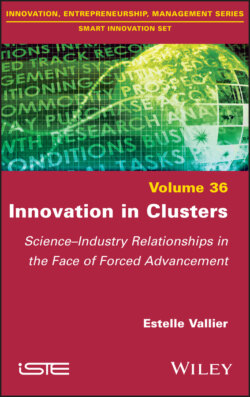Читать книгу Innovation in Clusters - Estelle Vallier - Страница 15
I.2.3. An immersion survey: observing, interviewing and quantifying on a daily basis
ОглавлениеThis survey, which was carried out as part of a CIFRE sociology thesis, is based on a variety of empirical material and combines qualitative (semi-directive interviews, participant observation, documentary and archival database of the biocluster) and quantitative (questionnaires and network analysis) methods.
On the qualitative side, the survey is based on 45 semi-structured interviews with a large proportion of laboratory directors and company managers, as well as with scientific directors, operations managers, chief financial officer (CFOs), communication and/or marketing managers, platform managers, research engineers, doctoral students, management assistants, physicians, etc.
These interviews were supplemented by a long phase of participant observation as a doctoral student at Genopole. This immersion was both conducive to the observation of official speeches (during colloquia organized by Genopolemeetings, visits by elected officials, etc.) and to participation in informal discussions. The confrontation of these two types of material gave rhythm to the research as a dialectic between political discourse and the reality of practice. In addition to observation, being on site provided access to certain documents archived by Genopole (activity reports since 1998, meeting minutes, press releases, digitized official documents, etc.) and to its internal database (management charts, files of accredited members, working documents, etc.).
In parallel, more quantitative material was collected over various stages of the survey. The first was a questionnaire, completed by the Genopole teams, on the expectations of employees in terms of coordination between the site’s structures, completed by 534 people. Although the sociological scope of the survey has its limits (due to its operational purpose), the number of respondents allows for a significant increase in generality.
Nevertheless, the quantitative material relies primarily on the network analysis method, which enables social interactions to be formalized using nodes and links on a graph. Nodes typically represent individuals or institutions, with links representing a particular type of interaction between two nodes. This method was adopted following the completion of a significant amount of qualitative work. As additional information became less and less significant with each new interview (saturation effect), it became essential, not to find missing data, but to observe the state of interactions at the cluster level. A relational database was therefore created on the basis of the ethnographic work carried out beforehand, and completed using the results of two questionnaires. The first, intended to observe the network at the inter-organizational level, was sent to all Genopole company and laboratory directors, the second to almost all the cluster’s employees via the Genopole intranet site. The first survey provided relational data for 42 of the site’s organizations16. The second survey collected responses from 102 people. However, the anonymity of the questionnaire did not enable the network to be mapped, but we were able to construct additional statistics based on the characteristics of the individuals interviewed and their relationship with the cluster17.
Table I.1. Summary of data collected
| Method | Material | Period |
| Observations | Research Officer attached to the General Management of Genopole | November 2013 to April 2017 |
| Consultation on expectations in terms of coordination | 534 responses from cluster workers | February to May 2014 |
| Documentary and archival data | Genopole archived documents and internal database | May 2014 to April 2017 |
| Semi-structured interviews | 45 interviews | May 2014 to April 2017 |
| Individual questionnaire for network analysis | 102 responses from cluster workers | February to April 2016 |
| Organizational Questionnaire for network analysis | 32 responses from laboratory and company directors in the cluster | February to April 2016 |
Since clusters cover multi-scale (organizational and individual), as well as historical and institutional dimensions, methodological diversity appears to be essential in order to understand a plurality of sociological mechanisms. Taking only a single approach does not make it possible to determine a set of dynamics, as the authors of the article focusing on the social capital of entrepreneurs (Lanciano-Morandat et al. 2009) point out in their conclusion. Indeed, the articulation of empirical methods (monographs, interviews, network modeling, archives, etc.) allows us to move away from current representations of clusters and to better support certain hypotheses (Forest and Hamdouch 2009, p. 17).
Within the context of this book, the methodology used allows for a better analysis of the hazards of day-to-day cooperation. Indeed, the structure of the book is based on the tension, mentioned above, between the conceptualization and concretization of the cluster. The first part reviews the socio-historical dimension of the cluster and the contemporary diffusion of its precepts on an international scale, in the French context and in a local context in Île-de-France. The second part questions the operability of the model within a particular biocluster by analyzing the resistance to cooperation in the various laboratories and companies.
